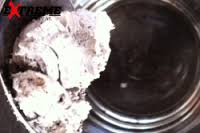 Shred charcoal in boiling water (seething, hence the subsequent soap seething, making). Add animal fats. As the water evaporates, there should be more charcoal added.
Shred charcoal in boiling water (seething, hence the subsequent soap seething, making). Add animal fats. As the water evaporates, there should be more charcoal added.
Or wash the ash with water, and then seven and cook it with oil. Continue cooking until excess liquid is evaporated.
Or melt fat by boiling it in water. Crush charcoal in a cloth, allow water seepage. Add these two together and cook until they are sufficiently concentrated.
(Allow to cool sufficiently before use, of course.)
You can make soap antiseptic by the addition of resin of a conifer or of horseradish. Herbal can.
For nicer and better soap, first make a lye: sieve wood ash and knead it with water into dough. Sprinkle quick lime in a dimple and sprinkle with water. Stir everything thoroughly. Fill a tub with tap half with straw. Pour everything in and add water. Leave a day and tap lye. You can cook it with fat to a jelly again. If you add salt, pure soap will float up. It will become hard if you allow it to drip. You can reuse the lye again.
Oxgall soap
Bile soap is known as a good stain remover (to auto mechanics and football players (or their mother)). Ox-gall soap is biodegradable and contains no chemical bleaches.
Rub stains with wet soap and let it soak.
Gall (or bile) has a complex composition. It is stored in the gallbladder, a pear-shaped storage bag against the front of the liver. The liver makes per day more than half a liter of bitter, green bile in the first part of the small intestine (the duodenum) where it breaks down fats into smaller units that digest faster. Bile is therefore an efficient emulsifier for fats and proteins.
Gall is also known as anti - grained agent in gouache (paint), and as a brightener in copper polish.
In 1850 stain removing soap was discovered by a pharmacist from Haarlem. In the absence of oxen now commonly bovine gal is used. The Dutch producer adds bile mixed with glycerine to soap granules, and heats it twice under high pressure up to 70 degrees.
The soap (often on the basis of coconut oil) is prepared separately.
The bile is possibly cooked with bright Venetian (or larch) turpentine, from the European larch. This resin contains one fifth of turpentine, the rest is mainly larizinol acid.
Thereafter, the cooling soap and bile are mixed to the desired ratio and thickness.
